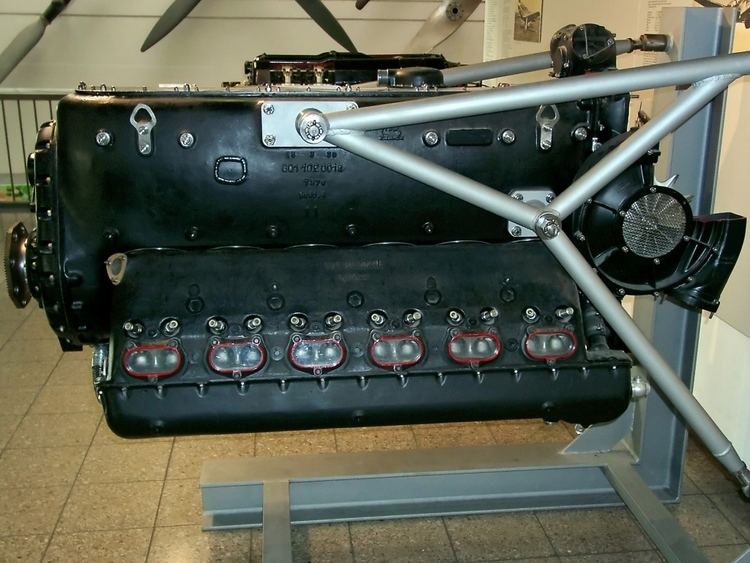The Daimler-Benz DB 601 was a German aircraft engine built during World War II. It was a liquid-cooled inverted V12, and powered the Messerschmitt Bf 109, among others. The DB 601 was basically an improved DB 600 with direct fuel injection.
The DB 601Aa was licence-built in Japan by Aichi as the Atsuta, by Kawasaki as the Ha-40, and in Italy by Alfa Romeo as the R.A.1000 R.C.41-I Monsone.
Based on the guidelines laid down by the German "Reichverkehrsministerium" (Ministry of Transport), in 1930 Daimler-Benz began development of a new aero engine of the 30 l (1,800 cu in) displacement class: a liquid-cooled inverted-vee 12-cylinder piston engine. This was designated F4, and by 1931 two prototypes were running on the test bench. These were followed by the improved F4B, which became the prototype for the DB 600.
In 1933, Daimler-Benz finally received a contract to develop its new engine and to build six examples of the DB 600. For the year after, the DB 600 was the only German aero engine in the 30-litre class. In total, 2281 DB 600s were built.
The DB 601A-1 was a development of the DB 600 with mechanical direct fuel injection. Like all DB 601s, it had a 33.9 litre displacement. The first DB 601A-1 prototype, designated as F4E, was test run in 1935, and an order for 150 engines was placed in February 1937.
Serial production began in November 1937, and ended in 1943, after 19,000 examples of all types were produced.
DB 601 A-1Up to 1,100 PS (809.0 kW; 1,085.0 hp) at sea-level with 2,400 rpm, up to 1,020 PS (750.2 kW; 1,006.0 hp) at 2,400 rpm and 4,500 m (14,800 ft) altitude, B4 fuel
DB 601 AaUp to 1,175 PS (864.2 kW; 1,158.9 hp) at sea-level with 2,500 rpm, up to 1,100 PS (809.0 kW; 1,085.0 hp) at 2,400 rpm and 3,700 m (12,100 ft) altitude, B4 fuel
DB 601 B-1Same as DB601 A-1 for use in
Messerschmitt Bf 110 and/or bomber aircraft (different prop/engine ratio, 1:1.88 instead of 1:1.55)
DB 601 BaSimilar to Aa for use in
Messerschmitt Bf 110 and/or bomber aircraft (different prop/engine ratio, 1:1.88 instead of 1:1.55)
DB 601 MFor use in the Heinkel He 100D 1,175 PS (864.2 kW; 1,158.9 hp)
DB 601 NUp to 1,175 PS (864.2 kW; 1,158.9 hp) at sea-level and at 4,900 m (16,100 ft) altitude with 2,600 rpm, C3 fuelUp to 1,270 PS (934.1 kW; 1,252.6 hp) at 2,100 m (6,900 ft) altitude with 2,600 rpm
DB 601 PSame as DB 601 N for use in Messerschmitt Bf 110 and/or bomber aircraft (different prop/engine ratio, 1:1.88 instead of 1:1.55)
DB 601 EUp to 1,350 PS (992.9 kW; 1,331.5 hp) at sea-level with 2,700 rpm, up to 1,320 PS (970.9 kW; 1,301.9 hp) with 2.700 rpm at 4,800 m (15,700 ft) altitude, B4 fuelUp to 1,450 PS (1,066.5 kW; 1,430.2 hp) at 2,100 m (6,900 ft) altitude with 2,700 rpm
DB 601 F/GSame as DB 601 E for use in Messerschmitt Bf 110,
Messerschmitt Me 210 and/or bomber aircraft (different prop/engine ratio,1:1.875 (601F), 1:2.06 (601G) instead of 1:1.685)
DB 606 A/BTwo DB 601 F or G coupled to work on a single propeller shaft for use in early Heinkel He 177As - 2,700 PS (1,986 kW) at sea level with a mirror-imaged starboard component engine supercharger, and derided as "welded-together engines" by
Reichsmarschall Hermann Göring in August 1942, from the problems they caused with engine fires in the He 177A during service from their inadequate installation design; such problems were not present in either the
Heinkel He 119 and
Messerschmitt Me 261 which also used them.
Alfa-Romeo R.A.1000 R.C.41-I MonsoneLicence built by Alfa Romeo in Italy
DB 601CANSA FC.20Dornier Do 215Heinkel He 100Henschel Hs 130A-0Kawasaki Ki-60Messerschmitt Bf 109Messerschmitt Bf 110Messerschmitt Me 210Savoia-Marchetti SM.88DB 606Heinkel He 119Heinkel He 177Junkers Ju 288CMesserschmitt Me 261Aichi AtsutaAichi M6AYokosuka D4YAlfa Romeo RA 1000 RC 41Macchi C.202Reggiane Re.2001Kawasaki Ha-40Kawasaki Ki-61Data from
Type: Twelve-cylinder liquid-cooled supercharged 60° inverted Vee aircraft piston engineBore: 150 mm (5.91 in)Stroke: 160 mm (6.30 in)Displacement: 33.93 l (2,070.54 cu in)Length: 1,722 mm (67.80 in)Dry weight: 590 kg (1,300 lb)Valvetrain: Two intake and two sodium-cooled exhaust valves per cylinder actuated via a single overhead camshaft per cylinder block.Supercharger: Gear-driven single-speed centrifugal type supercharger (later, hydraulic-driven)Fuel system: Direct fuel injectionOil system: Dry sump with one pressure and two scavenge pumpsCooling system: Liquid-cooledPower output:
1,175 PS (864.2 kW; 1,158.9 hp) at 2,500 rpm for takeoff1,070 PS (787.0 kW; 1,055.4 hp) at 2,400 rpm at 3,700 m (12,100 ft)Specific power: 25.52 kW/l (0.56 hp/in³)Compression ratio: 6.9:1Specific fuel consumption: 270 g/(kW·h) (0.44 lb/(hp·h))Power-to-weight ratio: 1.47 kW/kg (0.89 hp/lb)
